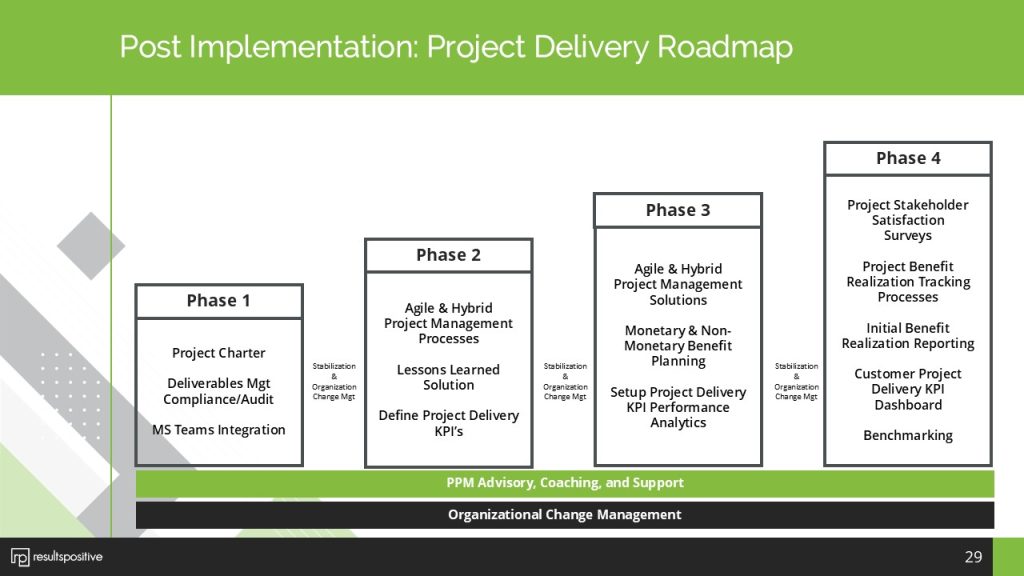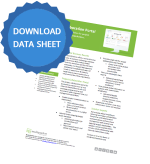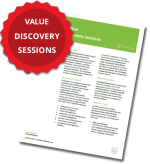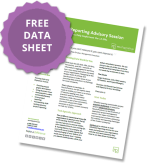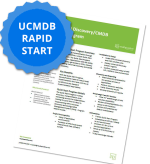The 4 Phases of a ServiceNow SPM Post-Implementation Roadmap
Implementing ServiceNow Strategic Portfolio Management (SPM) transforms how organizations manage their project portfolios, but the work doesn’t end when the system goes live. A ServiceNow SPM post-implementation review looks back to assess the implementation’s success, identifying strengths and areas for improvement. Building on this, a ServiceNow SPM post-implementation roadmap takes those insights and charts a forward-looking path to maximize value, optimize processes, and align with strategic goals. While the review is about understanding what has happened, the roadmap is about planning what comes next.
For IT Project Managers, C-Level Executives, and Change Management Professionals, a well-defined roadmap ensures that ServiceNow SPM evolves into a powerful tool for decision-making, resource management, and organizational growth. This blog post explores the four critical phases of a ServiceNow SPM post-implementation roadmap, offering a structured approach to leverage post-implementation data and drive continuous improvement.
Phase 1: Building a Strategic Foundation
The first phase of the ServiceNow SPM post-implementation roadmap focuses on establishing a strategic foundation based on the review’s findings. This sets the stage for all subsequent planning and ensures alignment with organizational priorities.
The Project Charter serves as the starting point. Drawing from the review’s insights—such as gaps in system adoption or unmet objectives—this document redefines the roadmap’s scope and goals. For executives, it provides a high-level vision, while project managers use it to prioritize tasks like enhancing integrations or refining workflows.
Deliverables Management builds on the review’s assessment of implementation outputs. If the review highlighted incomplete dashboards or underutilized features, this step plans their enhancement or redevelopment. This ensures the system supports portfolio managers in tracking projects effectively, addressing any deficiencies identified earlier.
Compliance and Audit planning ensures ongoing adherence to policies and standards. The review might have flagged security concerns or data inconsistencies, prompting the roadmap to include regular audits or updated configurations. This reassures executives of risk mitigation and supports a stable operational environment.
MS Teams Integration enhances collaboration based on review feedback. If stakeholders struggled to communicate during implementation, the roadmap might plan for dedicated Teams channels or training sessions. This fosters teamwork, a key concern for change management professionals aiming to improve user engagement.
Stabilization efforts from the review inform this phase, ensuring the system remains reliable, while organizational change management begins shaping future adoption strategies. This foundation turns review insights into actionable steps.
Phase 2: Refining Processes and Setting Benchmarks
Phase 2 leverages the review’s lessons to refine processes and establish benchmarks, turning insights into operational improvements within the ServiceNow SPM post-implementation roadmap.
Agile and Hybrid Project Management Processes evolve based on review findings. If the implementation revealed rigid workflows, the roadmap might plan for agile sprints to introduce flexibility. Project managers benefit from this adaptability, allowing them to address emerging needs efficiently.
Stabilization continues as a focus. The review might have identified performance issues, so the roadmap schedules ongoing system tuning or updates. This ensures reliability, giving executives confidence in the system’s longevity.
Lessons Learned Solution planning is central here. The review’s debriefs—covering implementation challenges or successes—guide the roadmap to implement corrective measures. For instance, if training gaps were noted, the plan might include targeted workshops, aiding portfolio managers in optimizing future use.
Organizational Change Management intensifies, using review data to address adoption hurdles. If users resisted new processes, the roadmap might outline change campaigns or support structures, a priority for change professionals ensuring smooth transitions.
Defining Project Delivery KPIs establishes new or refined benchmarks based on review outcomes. If the review showed weak performance tracking, the roadmap plans for specific KPIs—like project completion rates or resource efficiency—offering executives a measurable framework for success.
This phase transforms review insights into actionable process enhancements and performance goals.
Phase 3: Planning for Value and Performance Optimization
Phase 3 shifts the ServiceNow SPM post-implementation roadmap toward planning value delivery and optimizing performance, building on the review’s evaluation of outcomes.
Agile and Hybrid Project Management Solutions advance with review-driven adjustments. If the review pinpointed workflow inefficiencies, the roadmap might plan for custom solutions or integrations to streamline operations. This empowers project managers to enhance daily management tasks.
Monetary and Non-Monetary Benefit Planning takes shape from review findings. If the review highlighted missed financial gains or operational improvements, the roadmap outlines strategies to achieve them—such as better resource allocation or enhanced reporting. Executives gain a clear path to realize ROI.
Project Delivery KPI Performance Analytics planning leverages review data. If KPIs were underperforming, the roadmap schedules regular analysis using ServiceNow tools to track progress and identify trends. This supports portfolio managers in refining their approach and provides executives with actionable insights.
Stabilization remains a focus, with the review guiding ongoing system enhancements. Any lingering issues prompt planned updates, ensuring peak performance. Organizational Change Management continues, addressing review-identified resistance with tailored support, such as additional training, a key task for change professionals.
This phase turns the review’s outcomes into a proactive plan for value creation and system optimization.
Phase 4: Implementing Continuous Improvement and Success Metrics
The final phase of the ServiceNow SPM post-implementation roadmap focuses on implementing continuous improvement and measuring success, using review data to drive long-term growth.
Project Stakeholder Satisfaction Surveys are planned based on review feedback. If stakeholders expressed concerns, the roadmap schedules regular surveys to monitor satisfaction and gather input. This keeps change professionals informed and engaged in user needs.
Project Benefit Realization Tracking builds on review insights. If benefits were not fully realized, the roadmap plans for ongoing monitoring—tracking cost savings or decision-making improvements—offering executives tangible evidence of progress.
Initial Benefit Realization Reporting is scheduled to formalize achievements. Drawing from review findings, the roadmap outlines reports to highlight successes and lessons, fostering organizational support and momentum.
The Customer Project Delivery KPI Dashboard is designed with review data in mind. If the review showed a need for better visibility, the roadmap plans a customizable dashboard—tailored for project managers tracking timelines or executives assessing strategy alignment—enhancing decision-making.
Benchmarking concludes the phase, using review comparisons to industry practices. If the review suggested gaps, the roadmap plans regular benchmarking to identify improvement areas, inspiring innovation and competitiveness for executives.
Throughout, PPM Advisory, Coaching, and Support and Organizational Change Management provide ongoing guidance, ensuring the roadmap remains dynamic and effective.
Moving Forward
A ServiceNow SPM post-implementation roadmap transforms the retrospective insights of a post-implementation review into a proactive strategy for success. By progressing through the four phases—building a strategic foundation, refining processes and setting benchmarks, planning for value and performance optimization, and implementing continuous improvement and success metrics—organizations can ensure their ServiceNow SPM system evolves to meet future demands.
This roadmap empowers IT Project Managers with adaptable processes, provides C-Level Executives with a clear path to strategic value, and equips Change Management Professionals with tools to drive adoption. Embrace collaboration, act on review findings, and commit to iterative enhancements. With expert support and a tailored approach, your ServiceNow SPM post-implementation roadmap becomes a blueprint for sustained growth and excellence.

